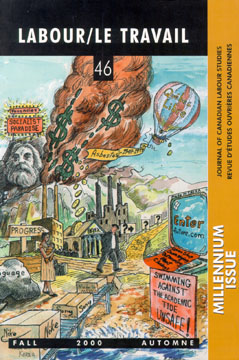Abstract
The asbestos strike of 1949 is without a doubt the labour conflict which has most deeply marked Quebec's historical consciousness. Since the 1956 publication of a volume on the strike, edited by Pierre Elliott Trudeau, the conflict has been interpreted as a success and a signal event in the social history of Québec. New research in various archival collections, however, leads us to revise this interpretation and to argue that the conflict was a serious defeat for the unions, and could have been even worse had it not been for the help of the clergy. In addition, our research highlights a neglected aspect of the strike — the project of enterprisere form (co-management, co-ownership, profit-sharing) brought forward by young clerics enamoured of ideas popular among Catholic intellectuals in Europe and who had found a sympathetic ear with certain Quebec bishops. These demands were taken up in turn by Catholic unions in Quebec, including the asbestos unions in 1948 and 1949. The mining companies were strongly opposed, and accused the unions of attempting to infringe on management rights. The Canadian Johns Manvilie Company insisted on adding a long paragraph on management rights to the collective bargaining agreement of 1950. The question was of interest as well to l'Association professionnelle des industriels, an employers' organisation founded in 1943 to bring together Catholic employers. This organisation fought strongly against the idea of co-management, complaining to religious authorities. But the final word belonged to the Pope who, in 1950, saw a danger of a slide toward socialist ideas. The promotion of enterprise reform was then abandoned by the clergy and back-burnered by the Catholic unions.
Résumé
La grève de l'amiante de 1949 est certes le conflit qui a le plus marqué la conscience historique des Québécois. Depuis la publication en 1956 du volume sur la grève dirigé par Pierre Elliott Trudeau, le conflit est interprété comme un événement capital dans l'histoire sociale du Québec. À partir d'une recherche neuve dans divers fonds d'archives, nous en avons revu l'interprétation en faisant ressortir que le conflit représente une défaite assez cuisante des syndicats, qui aurait pu encore être plus désastreuse n'eut été l'aide du clergé. En outre, notre recherche nous a permis de mettre en relief un enjeu négligé de la grève, le projet de réforme de l'entreprise (cogestion, copropriété, participation aux bénéfices) mis de l'avant par de jeunes clercs qui reprennent des idées alors en vogue chez des intellectuels catholiques en Europe et qui trouvent une oreille sympathique chez certains évêques québécois. Cette revendication est reprise par des syndicats catholiques au Québec dont ceux de l'amiante en 1948 et 1949. Les compagnies minières y sont fermement opposées accusant les syndicats de vouloir s'arroger les droits de la direction et la Canadian Johns Manville insiste pour ajouter à la convention collective de 1950 un long paragraphe sur son droit de gérance. La question intéresse aussi vivement un organisme patronal, l'Association professionnelle des industriels fondée en 1943 pour regrouper les patrons catholiques. L'organisme combat vivement l'idée de cogestion auprès des autorités religieuses. Mais le dernier mot appartient au pape qui, en 1950, y voit un danger et un glissement vers une mentalité socialiste. La promotion de la réforme de l'entreprise est alors abandonnée par les clercs et mis en veilleuse par les syndicats catholiques.
